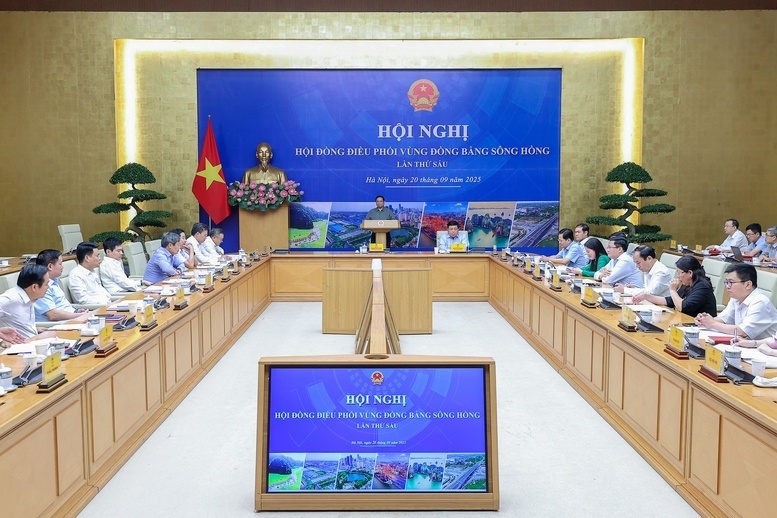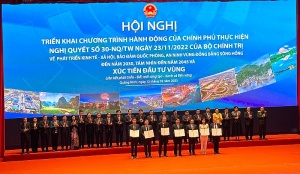Held on September 20, the session focused on shaping development strategies for the region following the recent mergers of provincial-level administrative units and the implementation of the two-level government model on July 1.
According to a report released at the meeting, the Red River Delta is a key strategic region for Vietnam’s politics, economy, culture, society, and national defence. As one of the country’s two most dynamic economic areas, it serves as a major growth pole, playing a decisive role in national development.
 |
| PM Pham Minh Chinh chaired the meeting of the Red River Delta Regional Coordination Council. Photo: VGP |
After the merger, the region includes six localities: Hanoi, Haiphong, Quang Ninh, Hung Yen, Bac Ninh, and Ninh Binh, all of which are economic locomotives of the region and the country.
The Red River Delta achieved positive results in the first half of 2025 when its economic growth rate reached 9.32 per cent, higher than the national average (7.52 per cent) and leading among the country’s six economic regions. In particular, many localities had strong breakthroughs, achieving double-digit growth rates such as Haiphong (11.2 per cent), Quang Ninh (11 per cent), Bac Ninh (10.5per cent), Ninh Binh (10.8 per cent).
The delta continues to draw in foreign investment, reaching $5.4 billion in the first eight months of 2025, accounting for 49.2 per cent of the total registered capital of the country. Of which, Bac Ninh leads the country in attracting fresh overseas capital, followed by Haiphong, Hung Yen and Ninh Binh.
It also ranks first in state budget revenue, posting the highest total among economic regions with over VND814.6 trillion ($32.58 billion) in the first eight months of 2025, equivalent to 46.8 per cent of the national total. Hanoi leads the region and ranks second nationwide with VND473.4 trillion ($18.93 billion), followed by Haiphong and Hung Yen.
Export turnover remains strong at $129.3 billion, representing about 32.5 per cent of the country’s total. Localities such as Bac Ninh, Haiphong, Hanoi, and Quang Ninh have recorded particularly high export growth rates.
The area has also been at the forefront in disbursing public investment capital, while achieving significant progress in the service sector and business development.
However, its current development model does not yet match its potential. Value chains and strong industry clusters are still underdeveloped, coordination and task implementation face challenges, and the progress of key projects and regional linkages remains slow.
Conference participants agreed that the Red River Delta must take the lead in implementing the newly issued Politburo resolutions to generate fresh momentum for national development.
While commending the region’s achievements, the PM urged localities to strengthen their leadership role in driving development across economic, social, and strategic sectors. First, they should lead efforts to achieve rapid and sustainable growth, improving the material and spiritual wellbeing of the population.
Second, the region should take the lead in restructuring the economy, increasing the share of industry and services, and transforming the growth model towards a green, digital, and circular approach grounded in science, technology, and innovation.
Third, localities must spearhead the implementation of the two-level local government system, ensuring it supports development, serves the people, and strengthens trust and efficiency for both domestic and foreign investors.
“The goal is to turn the Red River Delta into one of the most important driving forces of the country, together with the Southeast region, creating momentum and inspiration for the rest of the country, thereby encouraging rapid and sustainable growth nationwide,” said Prime Minister Chinh.
Key tasks for future development
To strengthen the region’s leadership role, the PM outlined a series of key tasks and solutions for the coming period.
Building on the Politburo’s conclusions and under the guidance of Deputy Prime Minister Nguyen Chi Dung, the Ministry of Finance and the Government Office will propose updates to the regulations and operating rules of regional councils. They will also submit recommendations to the Politburo and National Assembly on new approaches to regional development and coordination.
Authorities at all levels will review institutional bottlenecks in areas such as land, minerals, resources, auctions, investment, regional connectivity, and infrastructure development. The Ministry of Finance and the Government Office will consolidate these findings and present proposals to the National Assembly in the upcoming 10th Session.
On infrastructure – including transportation, telecommunications, energy, culture, education, sports, and healthcare – PM Chinh stressed the importance of linking local developments to maximise shared infrastructure use.
Regarding resources such as construction materials for key initiatives, he called for careful state management of allocation and pricing to ensure fairness, prevent past issues of price manipulation, and maintain equality across sectors and localities.
Local opinions on planning must be collected and incorporated to improve national, regional, sectoral, and local plans. Each level and agency should take responsibility, encourage decentralisation, and eliminate cumbersome procedures.
The government should work to increase state revenue, reduce unnecessary expenditure, and allocate more resources for development investment, while encouraging public-private partnerships.
The PM emphasised advancing science, technology, innovation, and digital transformation, including full implementation of Politburo Resolution 57 and related government directives.
Projects that have been delayed for long periods must be addressed urgently, removing obstacles related to procedures, planning, bidding, and auctions to free up resources.
Environmental issues must be tackled effectively, while social security is safeguarded and cultural and entertainment industries are developed. Heritage routes in the region should be connected and utilised efficiently.
Localities should strengthen regional and interregional linkages and expand international connections. Quang Ninh, for example, is set to deploy a cross-border economic cooperation zone linking with the Chinese market.
Finally, the government should promote smart governance, accelerate digital transformation, adopt AI, and recognise that people and staff are decisive factors in implementing these initiatives.
 |
Nearly $10 billion committed to Red River Delta region
Almost $10 billion was committed to the Red River Delta region at a conference for the government’s action plan for the development and safeguarding of the area until 2030 that took place yesterday in Halong, Quang Ninh. |



